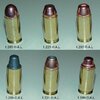I'm mainly getting FTRB's, no stove pipes but...I've been shooting mousefart loads so it might be a power issue. I picked up a box of Blaser Brass factory ammo to eliminate the retared monkey standing in front of the reloading press. If it craps the bed with those its probably going to be used for a trade up.
If I have time before we hit the range tomorrow I'll load up some full power Win231 or AutoComp loads with the RNFP's or use the full power Hornady XTP's over Autocomp that I have here for socialwork.
I've been running Kimber/McCormick/Star mags that have been 100% reliable in my Kimber Compact Stainless.
It's possible that my reloading has gotten sloppy since my Kimber, Hi-Point Carbine & Sig320(45acp) reliably run anything I throw at them.
Edited to add; it does not like a longer OAL even in spec (fails the plunk test) makes me wonder if the area just in front of the chamber is a bit tight. It handles empty brass fine so the chamber isn't cust too short.
OK, you've gotten lots of good advice so far, and my not-inflation adjusted 2 cents is only going to add so much to the discussion. However, you HAVE to try more than just that one bullet type before giving up on and ditching the pistol.
First off, a failure to return to battery isn't an ammunition power issue, it's an issue with how your ammunition is feeding and fitting into the chamber. Without the pistol in hand to see, it's almost impossible to figure out exactly where the fit issue is. My Colt Competition will give the occasional FTRB if I reload a case with a particularly chewed up case mouth that doesn't get smoothed out. You might not be taking enough crimp out, you might be causing a bulge somewhere by taking too much crimp out, you might have a bullet with a shoulder catching somewhere. Many, many possible options.
Secondly, find some 230 grain round nose bullets of almost any stripe. Full metal jacket, plated, lead, powder coated, something, anything that looks like a factory round nose profile. While my Colt will have the odd hiccup with 200 grain semi-wadcutter reloads with rough case mouths mentioned above, it is as reliable as sunrise and taxes with 230 grain RN or FMJ bullets. I'd expect any 1911 (or .45 ACP for that matter) in factory configuration, feeding from good magazines, to just work with 230 grain RN ammunition.
Third, when setting up to reload lead bullet .45 ACP ammo, I recommend pulling the barrel of the pistol you're loading for, and do the plunk test while loading up some dummy rounds to set your seating die. While you can get away with using book values with certain bullets, say standard FMJ and similar profiles, you may or may not get away with the book values with other bullet profiles. By other bullet profiles, I'm primarily looking at Hornady XTPs, semi-wadcutters, pretty much anything deviating from the standard RN ball profile. The way I do this is to start by seating the bullet long, then gradually turning the seating stem in until the round fits the chamber with the case head in the correct position relative to the barrel hood. Make sure your crimp is backed off for this, because you'll need to keep pushing the bullet deeper, and pushing against a crimp will create other fit issues. Once you have the seating depth down, adjust the crimp to remove your case flair until the round "plonks" into the chamber. At this point I'm ignoring book value cartridge OAL and recommended crimp diameter, and making sure the final cartridge fits MY chamber.
Four, similar to point three, you're going to have to experiment a little with some of the different bullet profiles. My pistol has a short throat, and I have to load SWCs so there's just barely a fingernail or two worth of bullet shoulder sticking out of the case. It's a similar story with Hornady XTPs and other jacketed bullets with the same profile: I have to seat them so the parallel shank of the bullet is mostly in the case. Once I have the seating depth and crimp adjustment down, I'll make up 2 or 3 dummy rounds to check to be sure they feed properly. In a 1911 I'll do the feed test with the recoil spring removed, so I can feel if the cartridge wants to hang up somewhere on the way into the chamber.
Fifth, if you want the easy button, find some Berry's 230 grain plated round nose bullets, seat them around 1.25" OAL, and push them with 5.0 grains of 231. It's lighter than full factory spec 230 grain .45 ACP hardball ammunition, but reliable. I have a stash of this load hanging around in case I ever get to make it to some of the local practical pistol matches.
@Steve in Allentown thank you for the picture. That's the second time in the last few days I've seen a recommended case base to bullet shoulder length for a loaded .45 ACP semi-wadcutter round. The part that caught my attention is your suggested dimension is .940", the other suggested measurement I saw is .920", and the Missouri Bullet Company 200 grain SWCs I have loaded up for my Colt measure .930".



